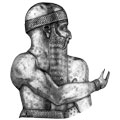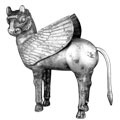Petrochemical Projects
 Click here to download this article.
Click here to download this article.
Parallel with his passion for ancient art, Houshang had another line of commercial activity in place. In the early 1970s, when Iranian crude oil was being exported at less than four dollars per barrel, the technological advancements of the newly-booming petrochemical industry and its ever-increasing demand for diverse products prompted Houshang to come up with an exploitation project. His idea consisted of the conversion of Iranian crude oil to petrochemical by-products, the importance of which was increasing daily due to the rising demands in consumption.
Apart from gathering the necessary information regarding the needed capital and technical execution, Houshang knew that the realisation of his project would only be possible if and when the government of Iran could form a joint venture with a reputable international oil company with strong expertise and technical know-how.
At the preparatory stage of his project in 1972/73, Houshang, with the assistance of a knowledgeable and experienced friend who was a petrochemical engineer, contacted Philips Petroleum Company (PPCo) (USA) which at the time was the largest international enterprise of its kind. It also had the most advanced resources at its disposal to execute giant projects, of the scale Houshang had in mind, anywhere in the world.
The envisaged capital was in the region of four billion dollars. That was to come from both partners in the order of the government of Iran above fifty per cent, and PPCo below forty-nine per cent of the shares.
After the project had been drawn up and the consent of PPCo had been acquired, the preliminary project was submitted for a feasibility study and a decision to the government of Iran (National Iranian Oil Company), and was approved by the latter. A copy of the agreement was also presented to the Shah, bearing in mind the special interest that he had towards the development of the Iranian petrochemical industry. In an attempt to set the project in motion, Houshang invited Mr William C. Douce, the President of PPCo, and a group of the company’s senior CEOs to Iran, following which he arranged for Mr Douce to meet the Shah at the Niavaran Palace in Tehran.
The choice of a construction site for the refinery in 1976-77, the harbour of Assaluyeh (an abandoned and forgotten Elamite harbour from five thousand years ago), which is the current site of National Iranian Oil Refining and Distribution Company on the coast of the Persian Gulf, was seen by the two parties as an ideal place. The Shah was particularly interested in making the project a success and he welcomed the idea of supervising the project personally.

Images of refinaries in Assaluyeh
In 1976, Mahboubian received a confidential message from Mr William Douce, the president of PPCo, to be reported directly to the Shah. The message contained a proposal that PPCo, using its advanced technology, was ready to assist Iran in building the largest liquid gas carrier fleets for exportation from the Persian Gulf to the rest of the world. The massive capital for this project was estimated at $17 billion. The message had an important clause attached to it: that should there be any obstacles to providing a budget for the venture, PPCo was ready to finance all of it. The Shah was in total agreement with this enormous and confidential project, on condition that it would first undergo a detailed feasibility study by the Iranian experts and that it would also be approved by the National Assembly of Iran.
The Shah and the Iranian government delegation were fully aware that the project to export massive quantities of liquid gas from the southern shores of Iran through the Persian Gulf to the rest of the world would make Iran the greatest financial power of the Middle East and the greatest producer of gas and petrochemical products. Moreover, by having full access to international waters Iran would secure for itself total and unimpeded freedom in the exportation of its own extracted gas. The advantages of this means of export heavily outweighed the disadvantages of the alternative, namely the heavy costs of pipeline construction and its maintenance, protection and security, taxes levied on pipelines crossing through several countries and most importantly, the political risks involved.
In the same year Jimmy Carter, the US President, and Cyrus Vance Sr, the US Secretary of State, took certain political measures regarding US foreign policy in the Middle East which had severe negative consequences, not only for the future of the Middle East but the world. Their actions were unreasonable and not well thought through. They were as follows:
-
The scheme to overthrow the Iranian monarchy and to eliminate the Shah was brought about decisively and aggressively by the direct and quick intervention of Cyrus Vance Sr and the Office of the US Department of State, through the US ambassador to Iran, Mr William H. Sullivan, in collaboration with his accomplice, General Hyser.
-
The misguided decisions and unwise measures taken by Jimmy Carter – the ex-President who many in the US and the world today consider to have been unpopular and incompetent - were instrumental not only in the fall of the Shah, but also in facilitating the rise of the Islamic Republic of Iran, the creation of instability in Middle Eastern countries – especially in the Persian Gulf - and paving the way to war in the region. For a long time to come, the world would have to pay for the frightening consequences brought about by those measures, from the point of view of security as well as the ever-increasing financial crisis which the world is currently facing. It is uncertain how long these repercussions will last.
Although the PPCo shouldered much of the expense of the progress of the Iranian petrochemical and gas projects, in 1977-78 the company ceased all its operations, undoubtedly as a direct consequence of US foreign policy under President Carter’s plan. The termination of the PPCo ventures in Iran, ie the construction of the petrochemical refinery and the exportation of gas, was a financial blow to Houshang Mahboubian. Particularly devastating was the impact of these events on his dream for the creation of a family museum in Tehran.





